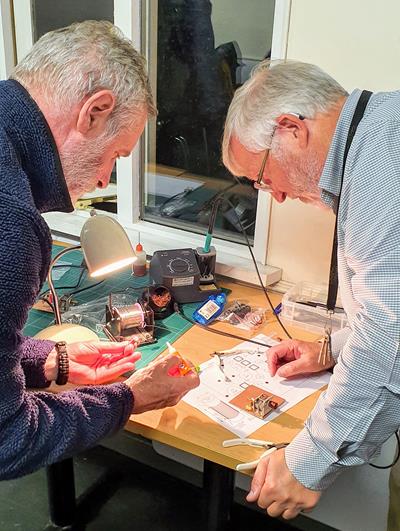Getting your Intermediate Amateur Radio Licence
One of the most rewarding courses I have ever done in my life has been the Amateur Radio Intermediate licence. This licence/course is a continuation from all the basic learning from the Foundation licence and does require more of a commitment in time and learning. Luckily, my local amateur radio club,
Dover Amateur Radio Club (DARC), ran a course and I was lucky to go through it step-by-step every Tuesday evening for a period of 12 weeks.
A major change from the
Foundation licence is the practical element of the course where you must create and build. The Intermediate licence aims to teach many of the fundamentals of radio as well as provide you with a competence in basic electronics. The course covers various subjects including licence conditions, basic electronics, transmitters & receivers and antennas as well as new subjects such as SDR (Software Defined Radio). The practical part of the course involves soldering a rudimentary circuit using some of the components you learned about on the course and building various other radio projects including building AM radio receiver, calibrating a variable frequency oscillator, building a simple DC circuit, making a patch lead, fitting a mains plug and measuring resistance with a multimeter.
One of the most essential items to have when doing the course is the ‘course bible’, the Intermediate Licence, Building on the Foundation book, which is available from the
RSGB. I received mine with the course, but I would check with your course provider/club to see if this is included in the price.
The main advantage of stepping up to the Intermediate licence is the increase in permitted operating power once you have passed the exam. You go from the 25 watts of the Foundation licence, up to 100 watts as an Intermediate Licence holder.
The main thing that I loved was the camaraderie with my fellow students who were a mixture of engineers coming into the hobby, those who had completed the Foundation licence and CB operators. We all helped each other out and gave each other mutual support.
What was also fabulous was the enthusiasm of the experienced tutors of DARC who had an abundance of knowledge and who conveyed it all it in a friendly way. It is amazing the wealth of engineering experience at an amateur radio club.
When I took the exam, it consisted of 45 multiple-choice questions covering all the sections from the Intermediate licence. The examination lasted one hour and 25 minutes. However, the exam has since been updated. It now consists of 46 multiple-choice questions and lasts 90 minutes. The exam paper was marked by the invigilator straight after the exam so, as with the Foundation, you have a good idea whether you passed or not. All exams, including the Intermediate licence, can now be taken remotely from home with online invigilators.
If I do have any advice for anyone considering taking the Intermediate licence is just go for it. Further from that, I would immediately book myself onto the Advanced Licence as keeping that information you have learnt will help you in achieving this top licence. Leaving time between the Intermediate and Advanced course might mean you will have to relearn the information again.
And when you get your official certificate through the post a few weeks late you not only have a feeling of achievement but pride as well.
You then log on to the Ofcom licensing system to apply for your licence. Ofcom will then issue you with your new, upgraded radio licence and you can get started immediately on the Intermediate frequency allocations at up to 100 watts power.
Go on, give it a go!
Ian Lockyer (2E0IAJ)
If you are interested in taking the Intermediate Licence or would like more details, visit the Radio Society of Great Britain website:
https://rsgb.org/main/clubs-training/for-students/intermediate/.
Picture kindly supplied by the RSGB

